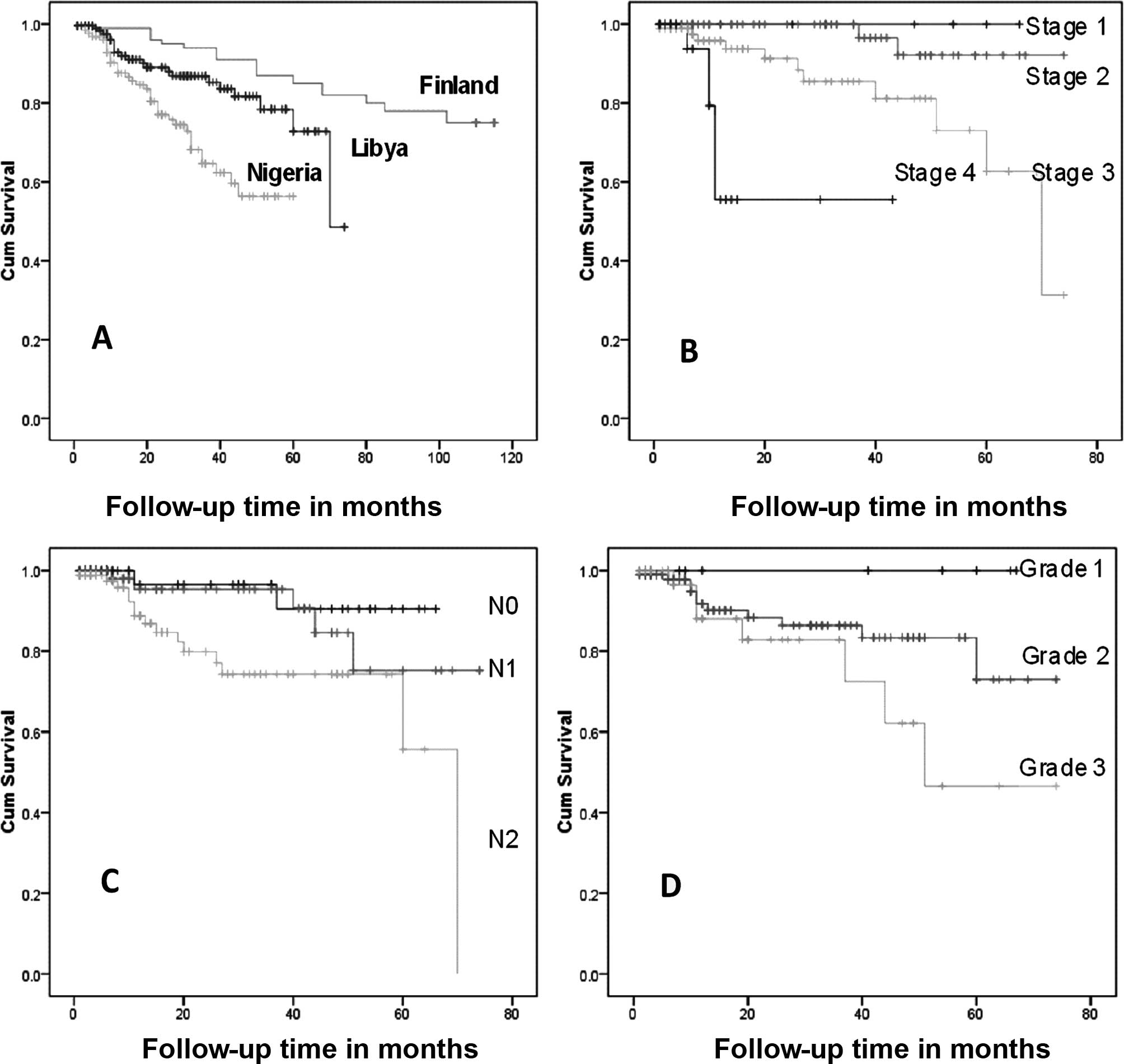|
1
|
Parkin D and Fernandez G: Use of
statistics to assess the global burden of breast cancer. Breast J.
12:S70–S80. 2006. View Article : Google Scholar : PubMed/NCBI
|
|
2
|
Wiliams C, Olopade O and Falkson C: Breast
cancer in women of African descent. Springer; Netherlands: 2006,
View Article : Google Scholar
|
|
3
|
American Cancer Society. Cancer facts and
figures for african Americans 2007–2008. American Cancer Society;
Atlanta: 2008
|
|
4
|
Nadia M, Iman G and Iman A: Cancer
pathology registry 2003–2004 and time trend analysis. NCI; Cairo:
2007
|
|
5
|
Bray F, Mc Carron P and Parkin D: The
changing global patterns of female breast cancer incidence and
mortality. Breast Cancer Res. 6:229–239. 2004. View Article : Google Scholar : PubMed/NCBI
|
|
6
|
Finnish Cancer Registry Report. http://http://www.cancerregestry.fi/stats/eng/veng001i0.htm.
2007
|
|
7
|
Statistical Information Team, Cancer
Research UK. Breast cancer. 2009, http://info.cancerresearchuk.org/cancerstats/index.htm.
|
|
8
|
Pompe-Kirn V, Japelj B and Primic-Zakelj
M: Future trends in breast, cervical, lung, mouth and pharyngeal
cancer incidence in Slovenia. Cancer Causes Control. 11:309–318.
2000. View Article : Google Scholar : PubMed/NCBI
|
|
9
|
Nagata C, Kawakami N and Shimizu H: Trends
in the incidence rate and risk factors for breast cancer in Japan.
Breast Cancer Res Treat. 44:75–82. 1997. View Article : Google Scholar : PubMed/NCBI
|
|
10
|
McBride R, Hershman D, Tsai W, Jacobson J,
Grann V and Neugut A: Within-stage racial differences in tumor size
and number of positive lymph nodes in women with breast cancer.
Cancer. 110:1201–1208. 2007. View Article : Google Scholar : PubMed/NCBI
|
|
11
|
James J: Differences in breast cancer
among African American and Caucasian women. CA Cancer J Clin.
50:50–64. 2000. View Article : Google Scholar
|
|
12
|
Chaouki N and El Gueddari B:
Epidemiological descriptive approach of cancer in Morocco through
the activity of the National Institute of Oncology from 1986 to
1987. Bull Cancer. 78:603–609. 1991.PubMed/NCBI
|
|
13
|
Ikpatt OF, Kuopio T, Ndoma-Egba R and
Collan Y: Breast cancer in Nigeria and Finland: Epidemiological,
clinical and histological comparison. Anticancer Res. 22:3005–3012.
2002.PubMed/NCBI
|
|
14
|
Sabratha Cancer Registry. First annual
report, 2006. African Oncology Institute. Sabratha, Libya: 2008
|
|
15
|
Eltwati A: Libyan healthcare system to
reform or transform? Jamahiria Med J. 7:162–163. 2007.
|
|
16
|
Libyan National Statistics Figures. Annual
Report. Tripoli: 2003, (in Arabic).
|
|
17
|
King T, Turnbull CP, Baver P, Lewis RM,
Pletcher K, Schreiber B, Shephered MC, Sparks KJ, Tikkanen A and
Wolff A: (eds from Encyclopedia Britannica, Inc.). Knauer K:
(contributing ed from Time, Inc.). Countries of the world. Time
Almanac 2009. Encyclopedia Britannica, Inc.; USA: pp. 218–544.
2009
|
|
18
|
Brazier C and Hamed A: The World Guide
2003–2004. An alternative reference to the countries of our planet.
New Internationalist Publications Ltd; Oxford: pp. 1–623. 2003
|
|
19
|
Statistics Finland. Finland in Figures.
http://www.stat.fi/tup/suoluksuoluk_vaesto_en.html.
|
|
20
|
Misurata Cancer Registry. Hospital Cancer
Registry. First annual report, 2008. 1st edition. National Cancer
Institute; Musrata, Libya: 2008
|
|
21
|
Jobling MA, Hurles M and Tyler-Smith C:
Human evolutionary genetics. Origin, peoples and disease. Garland
Science, Taylor and Francis group; New York: 2004
|
|
22
|
MacMahon B: Epidemiology and the causes of
breast cancer. Int J Cancer. 118:2373–2378. 2006. View Article : Google Scholar : PubMed/NCBI
|
|
23
|
Helmrich SP, Shapiro S, Rosenberg L,
Kaufman DW, Slone D, Bain C, Miettinen OS, Stolley PD, Rosenshein
NB, Knapp RC, Leavitt T Jr, Schottenfeld D, Engle RL Jr and Levy M:
Risk factors for breast cancer. Am J Epidemiol. 117:35–45.
1983.PubMed/NCBI
|
|
24
|
Rashad H, Osman M and Roudi-Fahimi F:
Marriage in the Arabic World Population reference Bureau.
www.prb.org/pdf05/marriageinarabworld_eng.pdfhttps://www.prb.org/pdf05/marriageinarabworld_eng.pdf.
2005
|
|
25
|
American Joint Committee on Cancer. AJCC
Cancer Staging Manual. 5th edition. Lippincott-Raven; Philadelphia:
1997
|
|
26
|
Smith RA: Mammography screening for breast
cancer. Northeast Florida Medicine; 2005
|
|
27
|
Gao YT, Shu XO, Dai Q, Potter JD, Brinton
LA, Wen W, Sellers TA, Kushi LH, Ruan Z, Bostick RM, Jin F and
Zheng W: Association of menstrual and reproductive factors with
breast cancer risk: results from the breast cancer study. Int J
Cancer. 87:295–300. 2000. View Article : Google Scholar : PubMed/NCBI
|
|
28
|
Ben Ahmed S, Aloulou S, Bibi M, Landolsi
A, Nouira M, Ben Fatma L, Kallel L, Gharbi O, Korbi S, Khairi H and
Kraiem C: Breast cancer prognosis in Tunisian women: analysis of a
hospital series of 729 patients. Santé Publique. 14:231–241.
2002.PubMed/NCBI
|
|
29
|
Sant M; Eurocare Working Group.
Differences in stage and therapy for breast cancer across Europe.
Int J Cancer. 93:894–900. 2001. View
Article : Google Scholar : PubMed/NCBI
|
|
30
|
Galea M, Blamey RW, Elston CW and Ellis
IO: The Nottingham prognostic index in primary breast cancer.
Breast Cancer Res Treat. 22:207–219. 1992. View Article : Google Scholar : PubMed/NCBI
|
|
31
|
Ellis IO, Galea M, Broughton N, Locker A,
Blamey RW and Elston CW: Pathological prognostic factors in breast
cancer. II. Histological type. Relationship with survival in a
large study with long-term follow-up. Histopathology. 20:479–489.
1992. View Article : Google Scholar : PubMed/NCBI
|












